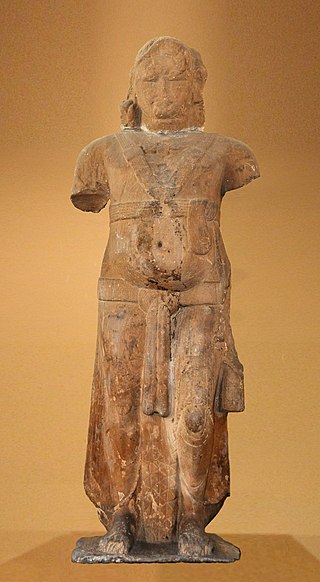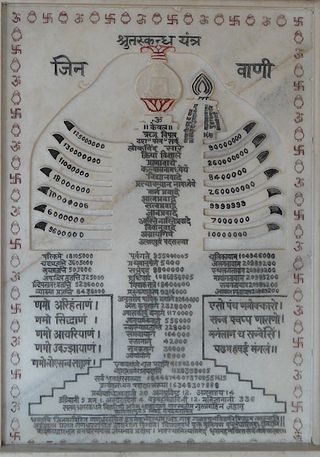
Mahavira, also known as Vardhamana, was the 24th Tirthankara of Jainism. He was the spiritual successor of the 23rd Tirthankara Parshvanatha. Mahavira was born in the early 6th century BCE into a royal Jain family of ancient India. His mother's name was Trishala and his father's name was Siddhartha. They were lay devotees of Parshvanatha. Mahavira abandoned all worldly possessions at the age of about 30 and left home in pursuit of spiritual awakening, becoming an ascetic. Mahavira practiced intense meditation and severe austerities for twelve and a half years, after which he attained Kevala Jnana (omniscience). He preached for 30 years and attained moksha (liberation) in the 6th century BCE, although the year varies by sect.

The Yakshas are a broad class of nature spirits, usually benevolent, but sometimes mischievous or capricious, connected with water, fertility, trees, the forest, treasure and wilderness. They appear in Hindu, Jain and Buddhist texts, as well as ancient and medieval era temples of South Asia and Southeast Asia as guardian deities. The feminine form of the word is IAST: Yakṣī or Yakshini.
Gina or GINA may refer to:
A Jain is a follower of Jainism, a religion of India.

Sthānakavāsī is a sect of Śvetāmbara Jainism which was created in medieval era. The Sthanakvasi, whose name refers to the sect’s preference for performing religious duties at a secular place such as a monks’ meetinghouse (sthanak) rather than at a temple, is different from the Murtipujaka sect in that it rejects idolatry. It believes that idol worship is not essential in the path of soul purification and attainment of Nirvana/Moksha. Sthānakavāsī accept thirty-two of the Jain Agamas, the Śvetāmbara canon, contending that the scriptures make no mention of idol worship and temples. According to the sect, Mahavira himself never endorsed idol worship, and they argue that such practices were borrowed from other religions by the Murtipujaka Jains.

The Pañca-Parameṣṭhi in Jainism is a fivefold hierarchy of religious authorities worthy of veneration.
Jai Jinendra! is a common greeting used by the Jains. The phrase means "Honor to the Supreme Jinas (Tirthankaras)"
Karangtengah inscription is the inscription written on five pieces of stones dated 746 Saka or 824 CE, discovered in Karangtengah hamlet, Temanggung Regency, Central Java, Indonesia. The inscription was written in ancient Javanese script in two languages; Old Javanese and Sanskrit. Lines 1-24 were written in Sanskrit, and the rest of the lines were written in old Javanese. The inscription is linked with the temples Borobudur and Mendut.

Jain sculptures or Jain idols are the images depicting Tirthankaras. These images are worshiped by the followers of Jainism. The sculpture can depict any of the twenty-four tirthankaras with images depicting Parshvanatha, Rishabhanatha, or Mahāvīra being more popular. Jain sculptures are an example of Jain art. There is a long history of construction of Jain sculptures. Early examples include Lohanipur Torsos which has been regarded to be from the Maurya period, and images from the Kushan period from Mathura.

Kharatara Gaccha is one of Shvetambara Murtipujaka Gacchas. It is also called the Vidhisangha or Vidhimarga, as they regard their practices as scripturally correct.

Jain art refers to religious works of art associated with Jainism. Even though Jainism has spread only in some parts of India, it has made a significant contribution to Indian art and architecture.

The Dhank Caves are located near Dhank village near Upleta, Rajkot district, Gujarat, India. They were chiseled out of a calcareous sandstone outcropping during the regime of the Western Satraps. The caves are influenced by Buddhist and Jain cultures. The Jain cave includes figures of Adinath, Shantinath and Pārśva. These are considered to be the earliest Jain sculptures in Kathiawad.

In Jainism, Jinvani means the message or the teachings of the Jina (arihant). It is made up of two words Jina (arihant) and Vani (voice). Often the words are spelled out separately or put together as "Jinavani" in publications. It is depicted in various forms, such as "Jinwani" which may be a hymn, and is also personified as Jinvani Maa. The omniscient form of Jina-Vani is said to be a letterless speech, when emanating from an arihant, which is understandable by all present, in their own language, as it is transformed into lettered discourse. In literature, discourses of the tirthankara are generally referred to as Jinvani, as well as Srutu Jnana, meaning scriptural knowledge.
John E. Cort is an American indologist. He is a professor of Asian and Comparative Religions at Denison University, where he is also Chair of the Department of Religion. He has studied Jainism and the history of Jain society over four decades, authored several books on Jainism, and is one of the editors of the forthcoming Brill Encyclopedia of Jainism. According to a review published in 2006 by Peter Flügel, the influence of the studies and publications of Cort on Jainism "have been immense", and in some respects dominated the field of Jain studies.

Vividha Tirtha Kalpa is a widely cited Jain text composed by Jinaprabha Suri in the 14th century CE. It is a compilation of about 60 Kalpas (sections), most of them give the accounts of major Jain Tirthas.

The Jain stupa was a type of stupa erected by the Jains for devotional purposes. A Jain stupa dated to the 1st century BCE-1st century CE was excavated at Mathura in the 19th century, in the Kankali Tila mound.

Bommalagutta is a Jain centre situated near Kurikyala village of Karimnagar district in Telangana. This Jain center is situated 3 km from another famous Jain center Kulpakji.
This page is based on this
Wikipedia article Text is available under the
CC BY-SA 4.0 license; additional terms may apply.
Images, videos and audio are available under their respective licenses.











